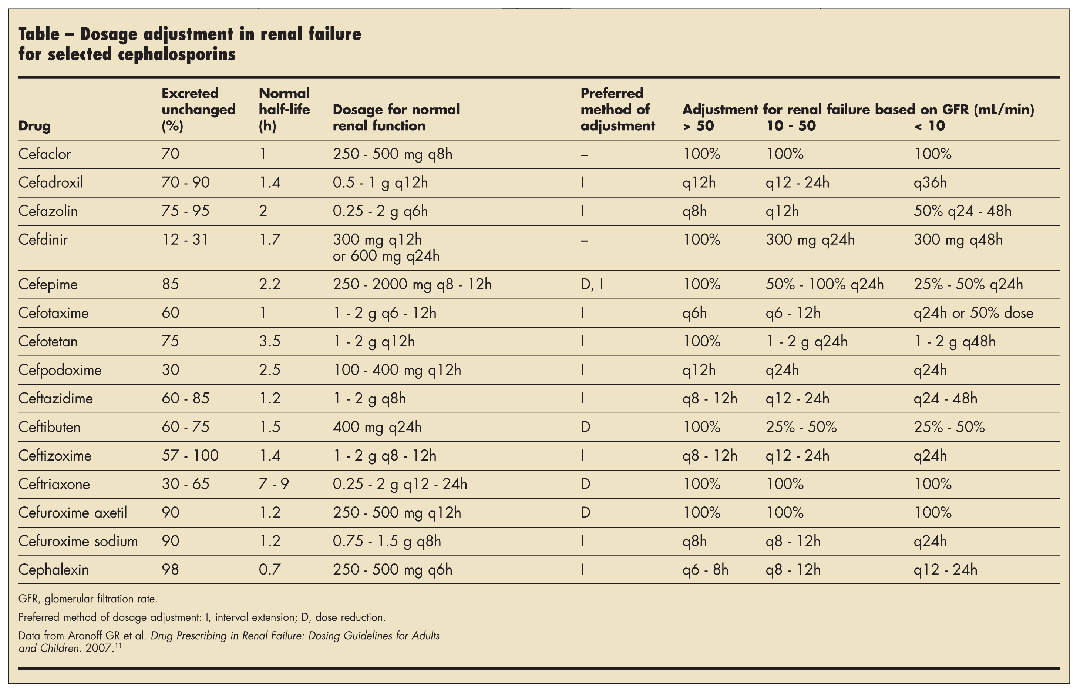- Clinical Technology
- Adult Immunization
- Hepatology
- Pediatric Immunization
- Screening
- Psychiatry
- Allergy
- Women's Health
- Cardiology
- Pediatrics
- Dermatology
- Endocrinology
- Pain Management
- Gastroenterology
- Infectious Disease
- Obesity Medicine
- Rheumatology
- Nephrology
- Neurology
- Pulmonology
Cephalosporins: How to Minimize the Risk of Neurotoxicity
Cephalosporins are usually considered relatively safe antibiotics; however, serious neurological adverse effects can occur following administration.1-5 Manifestations of cephalosporin-induced neurotoxicity may include confusion, disorientation, twitching, somnolence, myoclonus, and seizures, particularly in patients with reduced renal function.6,7 Here we discuss the mechanism, risk factors, and management of cephalosporin-induced neurotoxicity.
Cephalosporins are usually considered relatively safe antibiotics; however, serious neurological adverse effects can occur following administration.1-5 Manifestations of cephalosporin-induced neurotoxicity may include confusion, disorientation, twitching, somnolence, myoclonus, and seizures, particularly in patients with reduced renal function.6,7 Here we discuss the mechanism, risk factors, and management of cephalosporin-induced neurotoxicity.
MECHANISM OF NEUROTOXICITY
The chemical structure of cephalosporins differs from that of other -lactams in that they contain a 6-member thiazolidine ring fused to the -lactam portion. The -lactam ring is thought to be responsible for the epileptogenic properties of the cephalosporins. This is further demonstrated by evidence that an enzymatic cleavage of this ring results in the loss of epileptogenic effects.6
The exact mechanism of cephalosporin-induced neurotoxicity is not fully understood, but it may be related to competitive inhibition of γ-aminobutyric acid (GABA) binding caused by drug accumulation in the CNS.7 GABA is the primary inhibitory neurotransmitter in the brain, and inhibition of GABA can decrease the neuronal threshold and lead to excitation. Cephalosporin-induced neurotoxicity may also occur via a decrease in GABA levels or an increase in excitatory neurotransmitter release from nerve terminals.8
RISK FACTORS FOR NEUROTOXICITY
Elderly patients and infants are at risk for cephalosporin-induced neurotoxicity; other risk factors include preexisting CNS disease (eg, meningitis), excessive dosing, and impaired renal clearance.8,9 The exact role of aging is not well defined but may be related to a decrease in renal clearance, alterations of drug metabolism, or other changes in drug disposition.1
-Lactam antibiotics, including cephalosporins, have low CNS penetration in healthy persons.8,9 Alterations to the blood-brain barrier, such as occur in meningitis, significantly increase penetration and may be associated with toxic levels.9
Several studies indicate that impaired renal clearance is the most important predisposing factor for cephalosporin-induced neurotoxicity.6 In patients with impaired kidney function, standard doses (not adjusted for creatinine clearance) of renally eliminated cephalosporins may lead to high drug concentrations in the serum and CNS.8 In these cases, dosage adjustment is the best strategy for preventing cephalosporin-induced neurotoxicity.10 Recommended dosage adjustments for selected

cephalosporins are listed in the Table.11
MANAGEMENT OF NEUROTOXICITY
Benzodiazepine and barbiturates appear to be the most efficacious agents for the treatment of cephalosporin-induced seizures because of their effect on GABA activity.1 Management of other neurological symptoms involves early recognition and discontinuation of the offending agent.8
Although all -lactam antibiotics are neurotoxic to some extent,9 the risk can be reduced by recognition of risk factors and proper dosage adjustment.
References:
REFERENCES:1. Hantson P, Léonard F, Maloteaux JM, Mahieu P. How epileptogenic are the recent antibiotics? Acta Clin Belg. 1999;54:80-87.
2. Snavely SR, Hodges GR. The neurotoxicity of antibacterial agents. Ann Intern Med. 1984;101:92-104.
3. Slaker RA, Danielson B. Neurotoxicity associated with ceftazidime therapy in geriatric patients with renal dysfunction. Pharmacotherapy. 1991;11:351-352.
4. Herishanu YO, Zlotnik M, Mostoslavsky M, et al. Cefuroxime-induced encephalopathy. Neurology. 1998;50:1873-1875.
5. Sonck J, Laureys G, Verbeelen D. The neurotoxicity and safety of treatment with cefepime in patients with renal failure. Nephrol Dial Transplant. 2008;23:966-970.
6. Chow KM, Hui AC, Szeto CC. Neurotoxicity induced by beta-lactam antibiotics: from bench to bedside. Eur J Clin Microbiol Infect Dis. 2005;24:649-653.
7. Chow KM, Szeto CC, Hui AC, Li PK. Mechanisms of antibiotic neurotoxicity in renal failure. Int J Antimicrob Agents. 2004;23:213-217.
8. Lam S, Gomolin IH. Cefepime neurotoxicity: case report, pharmacokinetic considerations, and literature review. Pharmacotherapy. 2006;26:1169-1174.
9. Schliamser SE, Cars O, Norrby SR. Neurotoxicity of beta-lactam antibiotics: predisposing factors and pathogenesis. J Antimicrob Chemother. 1991;27:405-425.
10. Chatellier D, Jourdain M, Mangalaboyi J, et al. Cefepime-induced neurotoxicity: an underestimated complication of antibiotherapy in patients with acute renal failure. Intensive Care Med. 2002;28:214-217.
11. Aronoff GR, Bennett WM, Berns JS, et al. Drug Prescribing in Renal Failure: Dosing Guidelines for Adults and Children. 5th ed. Philadelphia: Versa Press; 2007.
